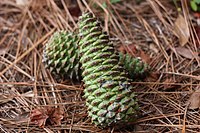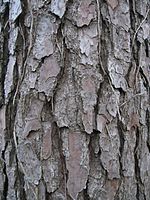Pinus taeda
| Pinus taeda | |
|---|---|

| |
| Characteristic appearance of loblolly pines, south Mississippi, USA | |
| Scientific classification | |
| Kingdom: | Plantae |
| Clade: | Tracheophytes |
| Clade: | Gymnospermae |
| Division: | Pinophyta |
| Class: | Pinopsida |
| Order: | Pinales |
| Family: | Pinaceae |
| Genus: | Pinus |
| Subgenus: | P.subg.Pinus |
| Section: | P.sect.Trifoliae |
| Subsection: | P.subsect.Australes |
| Species: | P. taeda
|
| Binomial name | |
| Pinus taeda | |

| |
| Natural range of loblolly pine | |
Pinus taeda,commonly known asloblolly pine,is one of severalpinesnative to theSoutheastern United States,fromEast TexastoFlorida,and north to southernNew Jersey.[2]Thewood industryclassifies the species as asouthern yellow pine.[3]U.S. Forest Servicesurveys found that loblolly pine is the second-most common species of tree in theUnited States,afterred maple.[4]For itstimber,the pine species is regarded as the most commercially important tree in the Southeastern U.S.[5][6][7]The common name loblolly is given because the pine species is found mostly in lowlands and swampy areas.[8]
Loblolly pine is the first among over 100 species ofPinusto have itscomplete genome sequenced.As of March 2014, it was the organism having the largest sequenced genome size. Its genome, with 22 billionbase pairs,is seven times larger thanthat of humans.[9][10]As of 2018, assembly of theaxolotlgenome (32Gb) displaced loblolly pine as the largest assembled genome.[11]The loblolly pine was selected as the official state tree ofArkansasin 1939.[12]
Description
[edit]Loblolly pine can reach a height of 30–35 meters (98–115 feet) with a diameter of 0.4–1.5 m (1.3–4.9 ft). Exceptional specimens may reach 50 m (160 ft) tall, the largest of the southern pines. Its needles are in bundles of three, sometimes twisted, and measure12–22 centimeters (4+3⁄4–8+3⁄4inches) long, an intermediate length for southern pines, shorter than those of thelongleaf pineorslash pine,but longer than those of theshortleaf pineandspruce pine.The needles usually last up to two years before they fall, which gives the species its evergreen character.[13]Needles are yellowish-green to grayish green.[13]
Although some needles fall throughout the year due to severe weather, insect damage, and drought, most needles fall during the autumn and winter of their second year. Theseed conesare green, ripening pale buff-brown,7–13 cm (2+3⁄4–5 in) in length,2–3 cm (3⁄4–1+1⁄4in) broad when closed, opening to4–6 cm (1+1⁄2–2+1⁄4in) wide, each scale bearing a sharp spine3 to 6 millimeters (1⁄8to1⁄4in) long.[2][14]
Bark is reddish brown and deeply fissured into irregular, broad, scaly plates on older trees. Branches are reddish-brown to dark yellowish brown.[13]
Loblolly pines are one of the fastest growing pines making it a valuable species in the lumber industry. The lumber marketed as yellow pine lumber and similar usage to other southern pines such as the more stronger Longleaf and Shortleaf pines. They are also used as pulpwood.[13]It grows at an average of 2 feet per year.[15]The tallest loblolly pine currently known, which is 51.4 m (169 ft) tall, and the largest, which measures 42 cubic meters (1,500 cubic feet) in volume, are inCongaree National Park.[16]
-
Mature unopened female cones
-
Bark on a mature tree
-
A gigantic old-growth loblolly pine, note human for scale
Etymology and taxonomy
[edit]The word "loblolly" is a combination of "lob", referring to thick, heavy bubbling of cookingporridge,and "lolly", an old British dialect word for "broth, soup, or any other food boiled in a pot". In the southern United States, the word is used to mean "a mudhole; a mire," a sense derived from an allusion to the consistency of porridge. Hence, the pine is named as it is generally found in lowlands and swampy areas.[8]Loblolly pines grow well in acidic clay soil, which is common throughout the South, thus are often found in large stands in rural places.
Other old names, now rarely used, include oldfield pine due to its status as anearly colonizerof abandoned fields; bull pine due to its size (several otheryellow pinesare also often so named, especially large isolated specimens); rosemary pine due to loblolly's distinctive fragrance compared to the other southern pines; and North Carolina pine.[17][13]
For thescientific name,Pinusis the Latin name for the pines andtaedarefers to the resinous wood.[18]
Ecology
[edit]With the advent ofwildfire suppression,loblolly pine has become prevalent in some parts of the Deep South that were once dominated by longleaf pine and, especially in northernFlorida,slash pine.[19]
Its rate of growth is rapid, even among the generally fast-growing southern pines. The yellowish,resinouswood is prized for lumber, but is also used forwood pulp.This tree is commercially grown in extensiveplantations.[3]
Loblolly pine is the pine of theLost Pines ForestaroundBastrop, Texas,and inMcKinney Roughs Nature Parkalong theTexas Colorado River.These areisolated populationson areas ofacidicsandysoil, surrounded byalkalineclaysthat are poor for pine growth.
A study using loblolly pines showed that higher atmospheric carbon dioxide levels may help the trees to endure ice storms better.[20]
Notable trees
[edit]The famous "Eisenhower Tree"on the 17th hole ofAugusta National Golf Clubwas a loblolly pine.U.S. PresidentDwight D. Eisenhower,an Augusta National member, hit the tree so many times that at a 1956 club meeting, he proposed that it be cut down. Not wanting to offend the President, the club's chairman, Clifford Roberts, immediately adjourned the meeting rather than reject the request outright. In February 2014, anice stormseverely damaged the Eisenhower Tree. The opinion ofarboristswas that the tree could not be saved and should be removed, which it subsequently was.[21]
The "Morris Pine" is located in southeastern Arkansas; it is over 300 years old with a diameter of 142 cm (56 in) and a height of 35.7 m (117 ft).[22]
Loblolly pine seeds were carried aboard theApollo 14flight. On its return, the seeds were planted in several locations in the US, including the grounds of theWhite House.As of 2016[update],a number of thesemoon treesremain alive.[23]
Genome
[edit]Pines are the most commonconifersand the genusPinusconsists of more than 100 species. Sequencing of their genomes remained a huge challenge because of the high complexity and size.[24]Loblolly pine became the first species with its complete genome sequenced.[9][25]This was the largest genome assembled until 2018, when theaxolotlgenome (32Gb) was assembled.[11]
The loblolly pine genome is made up of 22.18 billion base pairs, which is more than seven times that of humans.[10]Conifer genomes are known to be full ofrepetitive DNA,which make up 82% of the genome in loblolly pine (compared to only 50% in humans). The number of genes is estimated at 50,172, of which 15,653 are already confirmed. Most of the genes areduplicates.Some genes have the longestintronsobserved among fully sequenced plant genomes.[26]
Inbreeding depression
[edit]Gymnospermsare predominantlyoutcrossing,but lack geneticself-incompatibility.Loblolly pine, like most gymnosperms, exhibits high levels ofinbreeding depression,especially in the embryonic stage. The loblolly pine harbors an average load of at least eight lethal equivalents.[27]A lethal equivalent is the number of deleterious genes per haploid genome whose cumulative effect is the equivalent of one lethal gene. The presence of at least eight lethal equivalents implies substantial inbreeding depression upon self-fertilization.[citation needed]
See also
[edit]- Sonderegger pine,a hybrid between loblolly andlongleafspecies
References
[edit]- ^Farjon, A. (2013)."Pinus taeda".IUCN Red List of Threatened Species.2013:e.T42420A2978958.doi:10.2305/IUCN.UK.2013-1.RLTS.T42420A2978958.en.Retrieved19 November2021.
- ^abKral, Robert (1993)."Pinus taeda".In Flora of North America Editorial Committee (ed.).Flora of North America North of Mexico (FNA).Vol. 2. New York and Oxford: Oxford University Press – via eFloras.org,Missouri Botanical Garden,St. Louis, MO &Harvard University Herbaria,Cambridge, MA.
- ^abBaker, James B.; Langdon, 0. Gordon (1990)."Pinus taeda".In Burns, Russell M.; Honkala, Barbara H. (eds.).Conifers.Silvics of North America.Vol. 1.Washington, D.C.:United States Forest Service(USFS),United States Department of Agriculture(USDA) – via Southern Research Station.
{{citation}}:CS1 maint: numeric names: authors list (link) - ^Nix, Steve."Ten Most Common Trees in the United States".About.com Forestry.Retrieved11 January2013.
- ^"Loblolly Pine".Plant Information Center.Retrieved27 March2014.
- ^"Loblolly pine".Virginia Tech Forestry Department.Retrieved27 March2014.
- ^"Loblolly Pine".Tree Improvement Programme.Retrieved27 March2014.
- ^abThe American Heritage® Dictionary of the English Language(4th ed.). Houghton Mifflin Company. 2000.
- ^abZimin, Aleksey; Stevens, Kristian; et al. (Mar 2014)."Sequencing and Assembly of the 22-Gb Loblolly Pine Genome".Genetics.196(3): 875–890.doi:10.1534/genetics.113.159715.PMC3948813.PMID24653210.
- ^abMain, Douglas (20 March 2014)."Scientists Sequence The Largest Genome To Date".Popular Science.A Bonnier Corporation Company.Retrieved27 March2014.
- ^abEugene W. Myers, Sergej Nowoshilow (2018)."The axolotl genome and the evolution of key tissue formation regulators".Nature.554(7690): 50–55.Bibcode:2018Natur.554...50N.doi:10.1038/nature25458.hdl:21.11116/0000-0003-F659-4.PMID29364872.
- ^"47 Arkansas Facts".Meet The USA. 2022.
- ^abcdeGrimm, William Carey (1966).The Book of Trees.Harrisburg, Pennsylvania: The Stockpole Company. p. 48.
- ^Farjon, A. (2005).Pines: Drawings and Descriptions of the GenusPinus, ed.2. Brill, LeidenISBN90-04-13916-8.
- ^Gonzalez-Benecke, C. A., Martin, T. A., Clark, A. I., & Peter, G. F. (2010). Water availability and genetic effects on wood properties of loblolly pine (Pinus taeda). Canadian Journal of Forest Research, 40(12), 2265–2277.https://doi.org/10.1139/X10-162
- ^Earle, Christopher J., ed. (2018)."Pinus taeda".The Gymnosperm Database.
- ^Moore, Gerry; Kershner, Bruce; Tufts, Craig; Mathews, Daniel; Nelson, Gil; Spellenberg, Richard; Thieret, John W.; Purinton, Terry; Block, Andrew (2008).National Wildlife Federation Field Guide to Trees of North America.New York: Sterling. p. 73.ISBN978-1-4027-3875-3.
- ^"Oklahoma Biological Survey:Pinus taedaL. "Archived fromthe originalon 2010-06-22.Retrieved2010-04-29.
- ^Richardson, D. M., & Rundel, P. W. (1998). Ecology and biogeography of Pinus: an introduction. Pages 3–46 in Richardson, D. M., ed.Ecology and biogeography of Pinus.Cambridge University PressISBN0-521-55176-5.
- ^Greenhouse Gas Good for Some Trees- LiveScience.com
- ^Boyette, John (February 16, 2014)."Masters landmark Ike's Tree suffers major damage, removed".The Augusta Chronicle.Archived fromthe originalon 23 February 2014.RetrievedFebruary 17,2014.
- ^Bragg, Don C."The Morris Pine"(PDF).Bulletin of the Eastern Native Tree Society. Volume 1 (Summer 2006): 20.Retrieved2012-11-13.
- ^Williams, David R. (28 July 2009)."The" Moon Trees "".Goddard Space Flight Center.NASA.Retrieved8 March2016.
- ^Neves, Leandro G.; Davis, John M.; Barbazuk, William B.; Kirst, Matias (2013)."Whole-exome targeted sequencing of the uncharacterized pine genome".The Plant Journal.75(1): 146–156.doi:10.1111/tpj.12193.PMID23551702.
- ^Neale, David B; et al. (Mar 2014)."Decoding the massive genome of loblolly pine using haploid DNA and novel assembly strategies".Genome Biology.15(3): R59.doi:10.1186/gb-2014-15-3-r59.PMC4053751.PMID24647006.
- ^Wegrzyn, J. L.; Liechty, J. D.; Stevens, K. A.; Wu, L.-S.; Loopstra, C. A.; Vasquez-Gross, H. A.; Dougherty, W. M.; Lin, B. Y.; Zieve, J. J.; Martinez-Garcia, P. J.; Holt, C.; Yandell, M.; Zimin, A. V.; Yorke, J. A.; Crepeau, M. W.; Puiu, D.; Salzberg, S. L.; de Jong, P. J.; Mockaitis, K.; Main, D.; Langley, C. H.; Neale, D. B. (2014)."Unique Features of the Loblolly Pine (Pinus taeda L.) Megagenome Revealed Through Sequence Annotation".Genetics.196(3): 891–909.doi:10.1534/genetics.113.159996.PMC3948814.PMID24653211.
- ^Remington DL, O'Malley DM (2000)."Whole-genome characterization of embryonic stage inbreeding depression in a selfed loblolly pine family".Genetics.155(1): 337–48.doi:10.1093/genetics/155.1.337.PMC1461072.PMID10790407.
External links
[edit] Data related toPinus taedaat Wikispecies
Data related toPinus taedaat Wikispecies Media related toPinus taedaat Wikimedia Commons
Media related toPinus taedaat Wikimedia Commons




